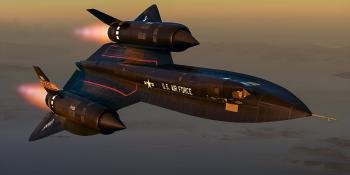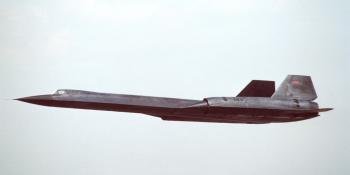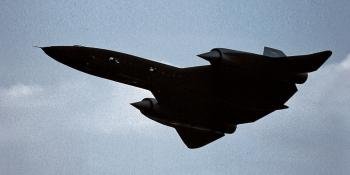Lockheed SR-71 Blackbird
Discover the fascinating history and technical details of the legendary Lockheed SR-71 Blackbird with our in-depth articles. From its top-secret development to its record-breaking flights, explore every aspect of this iconic spy plane!
Lockheed SR-71 Blackbird: a brief history
Few would dispute that Lockheed’s SR-71 Blackbird was among the most remarkable and instantly recognisable aircraft ever built. Throughout its years of service, it was the world’s fastest air breathing aircraft, and the highest-flying operational manned aircraft, breaking numerous performance records (see box).
Perhaps more importantly, during the air force reconnaissance missions it was designed for, its speed and altitude capability made it virtually invulnerable to enemy aircraft or surface-to-air missiles. Housed at Beale Air Force Base, of the 32 Blackbirds built, 12 were lost to accidents, but none were ever shot down.
Need for speed
The SR-71 owes its existence to the Cold War and the need for secrecy and speed. The West made great efforts to keep a watchful eye on the East’s military strength and movements of that strength. The Lockheed U-2 was superb in this role, its only flaw being its lack of speed. When that flown by Francis Gary Powers was shot down in 1960 over Soviet Union airspace, the US Central Intelligence Agency (CIA) approached Lockheed designer Clarence ‘Kelly’ Johnson to design a new aircraft capable of carrying out the same type of missions, but at much higher speed.
An aeronautical innovator, Johnson had already earned a reputation for his contributions to Lockheed’s World War Two-era P-38 Lightning, and its early jets including the P-80 Shooting Star and F-104 Starfighter. In 1955, at the CIA’s request, he initiated the construction of a new airbase at Groom Lake in Nevada, often referred to as ‘Area 51’. It was here that the U-2 was tested. The term ‘Skunk Works’ became an official alias for Lockheed Martin’s advanced development department.
The Blackbird’s predecessor was the A-12, an extraordinary single-seat reconnaissance aircraft that was almost identical to it in terms of external appearance. In late 1959, Skunk Works was awarded a contract to build five A-12s at a cost of $96 million (£59.8m). Building a large, Mach 3-plus capable aircraft out of titanium, supplies of which were largely controlled by the Soviet Union, proved immensely complex, and the first A-12 did not fly until April 1962.
Thirteen A-12s were made, including three YF-12A interceptor prototypes and two M-21 drone carriers. All were eventually powered by two Pratt & Whitney J58 engines, which also became the standard powerplant for the SR-71. The A-12 flew missions over North Korea and Vietnam, but was retired in 1968, partly due to the imminent arrival of the SR-71, the first of which flew on December 22, 1964.
Blackbird rises
Like its predecessor, the SR-71 was designed to fly faster than Mach 3, but could accommodate a flight crew of two – a pilot and a reconnaissance systems officer – in tandem cockpits. In an early attempt at ‘stealth’ design, its unusual and distinctive shape was a bid to minimise its radar cross-section. Similarly, its dark colour acted as camouflage against the night skies it operated in, leading to its call sign (and popular name) becoming ‘Blackbird’.
Around 85% of the SR-71 was constructed from titanium, allowing the airframe to cope with the high temperatures generated during Mach 3 flight. For the same reason, certain portions of its skin were ‘corrugated’, rather than smooth. The heat of high-speed flight would cause a smoother skin to split, whereas the corrugated surfaces could expand safely.
Although the SR-71 carried electronic countermeasures equipment, its greatest defence in hostile airspace was its pace – the mere act of acceleration would be enough to evade a surface-to-air missile, and it could outrun even the Soviet Union’s fastest interceptor, the Mikoyan-Gurevich MiG-25.
Little about the Blackbird was simple – or inexpensive. It required an unusual fuel mixture to operate effectively, and crews had to wear special full pressure flight suits to fly at the required altitude. Also, for maintaining route accuracy and target tracking at such high speeds, a form of astro-inertial navigation system (ANS) was devised, having previously been developed for missiles. The ANS, positioned behind the reconnaissance systems officer, worked by tracking stars through a circular window in the upper fuselage.
Like the A-12, the SR-71 operated over Vietnam, flying approximately one sortie a week for nearly two years from 1968. By 1972, this has risen to nearly one sortie every day. A detachment was based at Mildenhall, Suffolk, for several years. No Blackbirds were ever brought down by enemy forces. That said, 12 aircraft were lost to accidents, but only one crew member was killed in any of these.
Budget concerns dogged the Blackbird’s service through the 1970s, and a decision to retire the small fleet was made in 1989. With rising tension in the Middle East and North Korea, a few operational SR-71s were ‘reactivated’ from April 1995, giving this extraordinary machine a brief second life. NASA operated the last two airworthy Blackbirds until 1999. One of these, 61-7980 (NASA 844), made the type’s final flight on October 9, 1999.
SR-71 records
Anyone updating performance-related aviation records was kept particularly busy during the Blackbird’s flight testing and stellar career. On July 28, 1976, SR-71 61-7962 set a new ‘absolute altitude record’ of 85,069ft (25,929m), a height never since exceeded in sustained flight. On the same day, 61-7958 set a new speed record of 2,193.2mph (3,529.6km/h). The Blackbird also set a ‘speed over a recognised course’ record on September 1, 1974, flying from New York to London (3,508 miles) in just 1 hour 54 minutes and 56.4 seconds. The type set at least four other course-related speed records.









